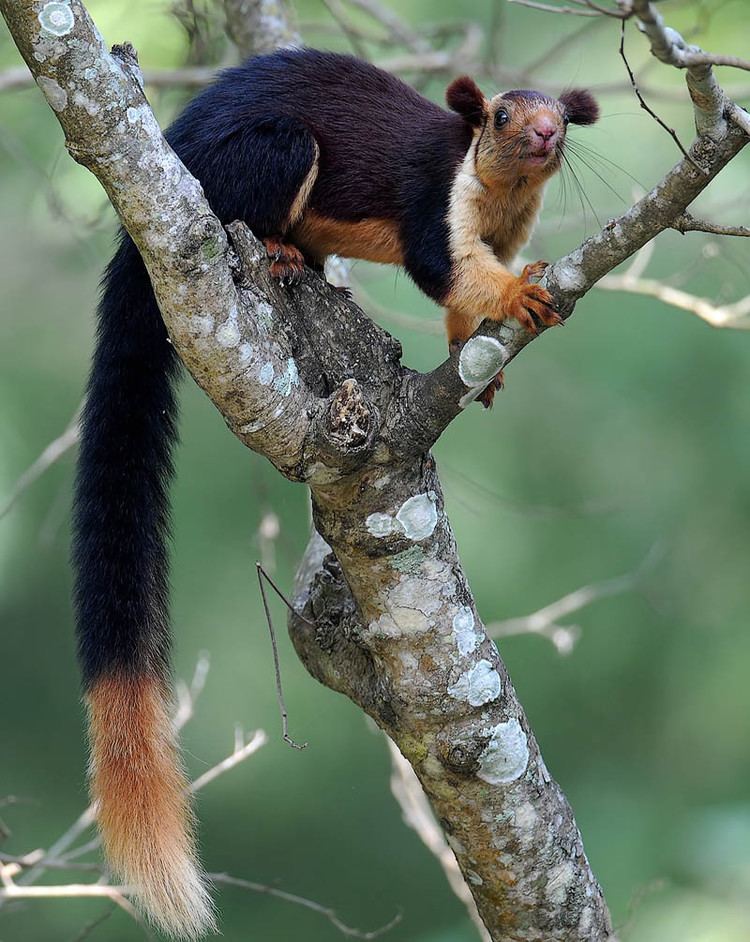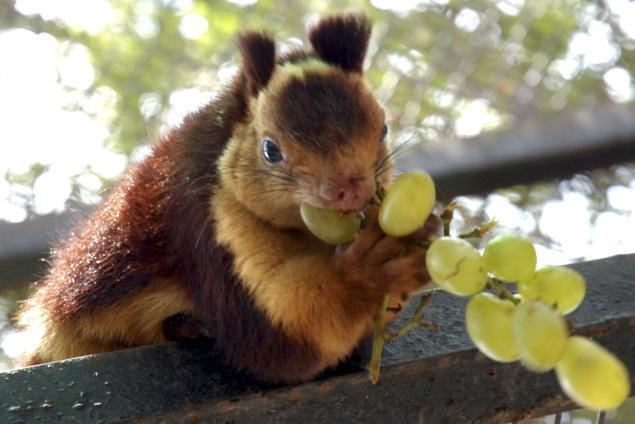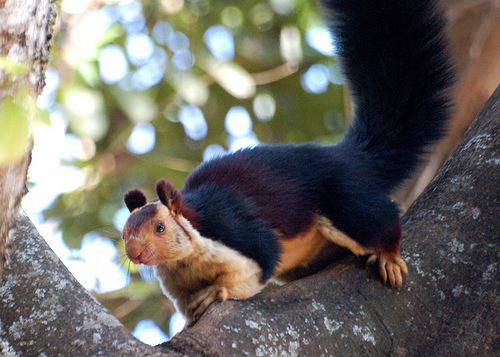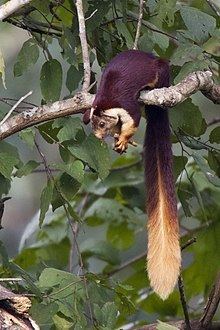Scientific name Ratufa indica | ||
 | ||
Similar Squirrel, Oriental giant squirrel, Mammal, Grizzled giant squirrel, Indian palm squirrel | ||
Indian giant squirrel in central indian forest
The Indian giant squirrel, or Malabar giant squirrel, (Ratufa indica) is a large tree squirrel species genus Ratufa native to India. It is a large-bodied diurnal, arboreal, and herbivorous squirrel found in South Asia.
Contents
- Indian giant squirrel in central indian forest
- Indian giant squirrel shrikant madhav kelkar
- Description
- Behavior
- Distribution
- Subspecies
- Family life
- Reproduction
- Bhimashankar Wildlife Sanctuary
- References

Indian giant squirrel shrikant madhav kelkar
Description

R. indica has a conspicuous two-toned (and sometimes three-toned) color scheme. The colors involved can be creamy-beige, buff, tan, rust, brown, or even a dark seal brown. The underparts and the front legs are usually cream colored, the head can be brown or beige, however there is a distinctive white spot between the ears. Adult head and body length varies around 14 inches (36 cm) and the tail length is approximately 2 ft (0.61 m). Adult weight - 2 kg (4.41 lb).
Behavior

The Indian giant squirrel is an upper-canopy dwelling species, which rarely leaves the trees, and requires "tall profusely branched trees for the construction of nests." It travels from tree to tree with jumps of up to 6 m (20 ft). When in danger, the Ratufa indica often freezes or flattens itself against the tree trunk, instead of fleeing. Its main predators are the birds of prey and the leopard. The Giant Squirrel is mostly active in the early hours of the morning and in the evening, resting in the midday. It is a shy, wary animal and not easy to discover.

They are typically solitary animals that only come together for breeding. The species is believed to play a substantial role in shaping the ecosystem of its habitat by engaging in seed dispersal.
Distribution

The species is endemic to deciduous, mixed deciduous, and moist evergreen forests of peninsular India, reaching as far north as the Satpura hill range of Madhya Pradesh (approx. 22° N).

As can be seen in the range map of this species, it occupies isolated ranges that are widely separated from each other, thus producing conditions favorable for speciation. The squirrels found within each of these isolated ranges share distinctive color schemes, making it easy to identify which region a particular squirrel is from, as well as leading to the controversy (see section below on Subspecies) as to whether these different color schemed subspecies ought to be considered as unique species.
Subspecies
There is some disagreement between biologists regarding how many subspecies belong to the Ratufa indica lineage. It is generally acknowledged that there are either four or five subspecies, depending on the source. This discrepancy is based on two separate lines of research, dating back to the 18th century. However, the most current data indicates that one of the subspecies (R. i. dealbata) claimed by those supporting the four subspecies stance has disappeared from its range in the province of Gujarat. Subsequently, it could also be argued that there are only three subspecies remaining.
The different subspecies lists are indicated below, along with some of the corresponding references.
Five Subspecies List (Ellerman, 1961):
Four Subspecies List (Moore and Tate, 1965):
To further complicate things, there is yet still more disagreement about the classification of this species' subspecies. Some biologists maintain that there should be up to eight subspecies considered, due to the fact that there are eight different distinct color schemes found among this species, and these are based on geographical ranges with intervening areas that separate the squirrel populations from one another.
Finally, there is still another point of disagreement in which some biologists consider that some of these subspecies ought to be elevated to be considered their own species. In this case, the general agreement would be that there would be four or five species created out of Ratufa indica's subspecies.
To sum this up, this species either has three, four, five or eight subspecies, or it may end up having none. This irresolution has been going on for over a century, and there is no indication that it will be resolved anytime soon. It is important to note, when dealing with this species, that there is this disagreement, and even if it is resolved in the future, there will still be much confusion within the literature that has already been published. So, it is good to keep this in mind when reading or studying this species, in order to avoid potential confusion.
Here are some brief descriptions of some of the color schemes and subspecies:
The table below lists the four recognized subspecies (based on Thorington & Hoffmann 2005) of Ratufa indica, along with any synonyms associated with each subspecies:
Family life
The Indian Giant Squirrel lives alone or in pairs. They build large globular nests of twigs and leaves, placing them on thinner branches where large predators can't get to them. These nests become conspicuous in deciduous forests during the dry season. An individual may build several nests in a small area of forest which are used as sleeping quarters, with one being used as a nursery.
Reproduction
Captive breeding of the Malayan giant squirrel, a close relative has indicated births in March, April, September and December. The young weigh 74.5 g at birth and have a length of 27.3 cm. In Canara, the Indian Giant Squirrel has been spotted with young in March.
Bhimashankar Wildlife Sanctuary
Bhimashankar Wildlife Sanctuary was created in the Ambegaon and Khed talukas of Pune District, in the Western Indian state of Maharashtra in order mainly to protect the habitat of the Indian giant squirrel, its area is 130 km2 and is a part of the Western Ghats (Sahyadri Ranges). This sanctuary was created in 1984.
